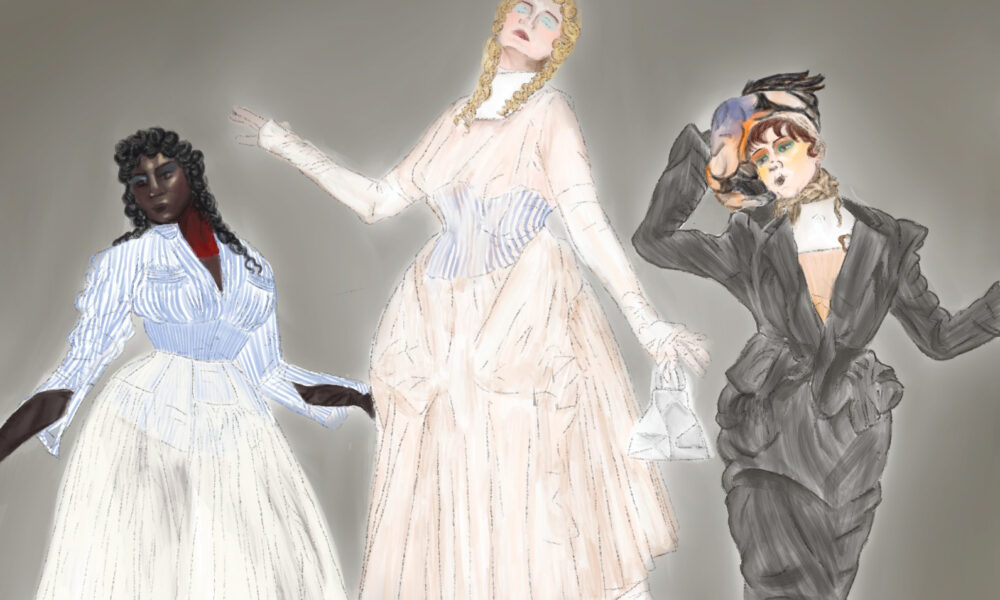A threat of danger plagues the foggy underside of the stone bridge as a frenetic figure sprints into the audience’s view. The noir-like dimness of the cobbled structure conceals the silhouette, lit only by distant beams of pale moonlight over the bridge. The shadow stops abruptly, tripping over its feet and assuming a contorted crouch, unnerving and frightening in its severity. Lamp posts brighten to reveal model Leon Dame rising to catch his breath. His tightly corseted waist slithers into the light of the lamps’ bloom, which illuminates his unearthly face: Dame’s skin shines like a porcelain doll covered in an organized mess of pigmented pastels.
The design aspects of Maison Margiela’s spring 2024 couture show, which premiered on Jan. 25, are avant-garde and unsettlingly strange. Creative director John Galliano’s anti-fashion designs are a retreat into the uncanny, an imagining of physical modernization to the point of bodily dystopia. With Pat McGrath’s ethereal makeup, the collection heightens to a level of contradicting otherworldliness and familiarity. This uniquely 20th-century perspective allows themes of simultaneous technological uncertainty and acceptance to find their way into today’s wardrobes.
Under rapid technological development, the visual elements of art tend to mirror innovations to process these radical changes. Creative processes—fashion styles in particular—are often reactionary, drawing from influences of everyday life to physically emulate social attitudes toward topics such as modernization. Recent advancements in artificial intelligence, communication, and augmented realities support a world reliant on technology for everyday interaction, which poses the question of its creation: What are the extents to which technology is an art form in itself?
This is not the first time that fashion has shifted with attitudes towards advancement. The stylistic futurism of the 1980s directly resulted from artists’ growing fascination with technology’s endless possibilities. Avant-garde fashion styles emerged following the invention of personal computers, cell phones, and digitized music in the form of CDs. Trends of capacious silhouettes altered the form of the body just as computers and cell phones altered life in the public sphere. Iconic ’80s designer Thierry Mugler exemplifies this influence in high fashion with his diverse designs of the exaggerated female form: Sharp shoulder pads, bold colours, and the use of unconventional materials, sometimes combining metals, latex, tulle, and exotic feathers to rebel against stylistic expectation. His work aims to transcend the expectations of traditional fashion and define the essence of the decade, one reliant on experimentation to obtain bodily modernity in a world of unrelenting transformation.
Maison Margiela’s new collection also contains several distinct influences from the ’80s subculture called New Romanticism. The New Romantics, originating in the British New Wave and glam rock music scene, adorned themselves in pale and pigmented makeup styles, androgynous silhouettes, and a sense of overall theatricality as a way of embracing the frivolity of life. New Romanticism took much inspiration from the flamboyance of 18th-century French fashion styles of the Romantic Period. The subculture was a revival of both its style and attitude, known for its ability to combine tradition with the futuristic opinions of the decade, which bears a striking resemblance to the current state of fashion. Maison Margiela’s 23rd look mirrors much of the male silhouettes and styles of the New-Romantic and foundational Romantic period with its slim-straight plaid breeches and tweed suit jacket tapered at the waist.
By referencing trends of modernism from the past, designers such as Margiela subvert all cyclical expectations. The collection exemplifies the intentions of modern fashion: It embraces the past while carving out its own individuality based on contemporary ideals and attitudes.








